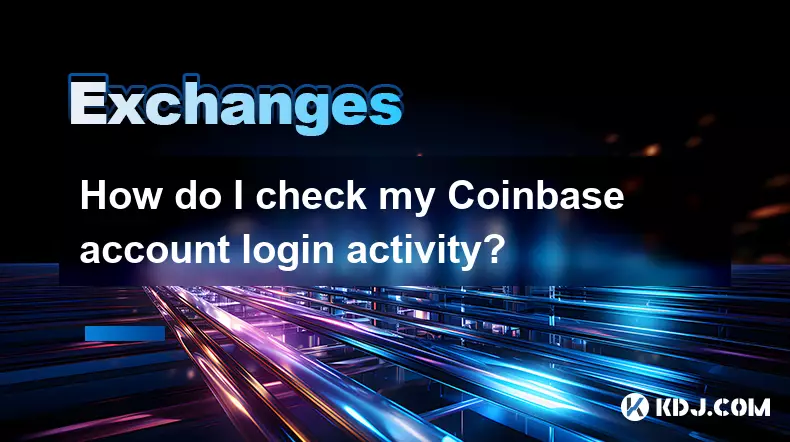-
 bitcoin
bitcoin $118548.520763 USD
3.67% -
 ethereum
ethereum $4352.564943 USD
4.79% -
 xrp
xrp $2.964058 USD
4.22% -
 tether
tether $1.000565 USD
0.05% -
 bnb
bnb $1028.372955 USD
1.46% -
 solana
solana $221.373507 USD
6.00% -
 usd-coin
usd-coin $0.999933 USD
0.02% -
 dogecoin
dogecoin $0.248633 USD
6.85% -
 tron
tron $0.341444 USD
2.38% -
 cardano
cardano $0.852946 USD
5.82% -
 hyperliquid
hyperliquid $47.869306 USD
6.15% -
 chainlink
chainlink $22.561476 USD
6.01% -
 ethena-usde
ethena-usde $1.001258 USD
0.05% -
 avalanche
avalanche $30.660000 USD
2.06% -
 stellar
stellar $0.400917 USD
9.76%
How do I check my Coinbase account login activity?
Monitor your Coinbase login history for unfamiliar IPs or locations, and enable real-time alerts to detect and respond to unauthorized access promptly.
Sep 19, 2025 at 03:18 pm

Login Activity Monitoring on Coinbase
1. Log in to your Coinbase account through the official website or mobile application. Once authenticated, navigate to the top-right corner of the interface and click on your profile icon. Select “Settings” from the dropdown menu to access account-specific options.
2. Within the Settings section, locate the “Security” tab. This area provides detailed information about your account’s protective measures, including two-factor authentication, connected devices, and recent login attempts. Click on “Login history” or “Recent activity” to view a chronological list of access events.
3. The login activity page displays data such as the date and time of each login, the IP address used, the geographical location derived from that IP, and the device type (e.g., desktop, mobile, browser). This information helps identify unfamiliar sessions that may indicate unauthorized access.
4. If you notice any suspicious entries, Coinbase allows users to take immediate action. Options include logging out of active sessions remotely and resetting your password instantly. It is also recommended to enable advanced security features like hardware-based two-factor authentication for added protection.
5. Regularly reviewing your login history strengthens your account's resilience against potential breaches. Unrecognized locations or repeated failed login attempts should prompt a full security audit, including updating recovery phrases and verifying email and phone number associations.
Enhancing Account Security Through Alerts
1. Coinbase offers real-time notifications for critical account activities. To activate these alerts, go to the “Notifications” section under Settings and ensure that email and push notifications for logins are enabled.
2. These alerts provide instant updates whenever a new device or browser accesses your account. Receiving confirmation outside your usual pattern allows for rapid response, minimizing exposure if credentials have been compromised.
3. Users can customize alert preferences based on severity. High-priority triggers include logins from new countries, changes to withdrawal addresses, and adjustments to two-factor settings.
4. Staying informed through timely alerts supports proactive defense strategies. Subscribing to all relevant notification channels ensures no significant event goes unnoticed.
5. In cases where an alert indicates a potential threat, Coinbase advises immediately securing the account by invalidating active sessions and conducting a comprehensive review of linked applications and API keys.
Device Management and Session Control
1. Under the Security settings, users can view all devices currently authorized to access their Coinbase account. Each entry includes details like operating system, browser version, and last login timestamp.
2. Removing outdated or unrecognized devices limits potential attack vectors. Simply select the device and choose “Log out” to terminate its session permanently.
3. Managing active sessions prevents lingering access points that could be exploited even after password changes. This step is especially crucial following the use of public computers or shared networks.
4. Periodic cleanup of trusted devices reinforces hygiene practices. Retaining only essential, frequently used devices simplifies oversight and reduces risk surface.
5. After removing unknown devices, consider setting up biometric authentication on personal smartphones to further restrict access to verified hardware only.
Recovery and Emergency Protocols
1. In the event of suspected unauthorized access, initiating a password reset is mandatory. Use the “Forgot password” function only through the official domain to avoid phishing traps.
2. Restore account control using your registered recovery email and backup codes. Never share these with third parties, regardless of how legitimate a request may appear.
3. Contact Coinbase support immediately if funds have moved without authorization or if recovery options are inaccessible. Provide timestamps, IP references, and screenshots of suspicious activity to expedite verification.
4. Review and update your two-factor authentication method. Avoid SMS-based 2FA due to SIM-swapping vulnerabilities; instead, opt for authenticator apps or hardware tokens.
5. Document every step taken during the recovery process. Maintaining records assists both personal audits and official investigations if necessary.
Frequently Asked Questions
Can I see login attempts that failed?Yes, Coinbase logs unsuccessful login attempts alongside successful ones. These entries appear in the same security activity section and include IP addresses and timestamps, helping detect brute-force attacks.
Does Coinbase notify me when I log in from a new device?Yes, provided notifications are enabled. You will receive an email and/or push alert confirming the new login, including location and device details for verification.
How long does Coinbase retain login history?Login records are stored for several months, though exact retention periods may vary. Continuous monitoring is advised since older entries may eventually rotate out of view.
What should I do if I can’t access my recovery email?Regain access to your email provider first. If unable to recover it, contact Coinbase support with identity verification documents to explore alternative account restoration paths.
Disclaimer:info@kdj.com
The information provided is not trading advice. kdj.com does not assume any responsibility for any investments made based on the information provided in this article. Cryptocurrencies are highly volatile and it is highly recommended that you invest with caution after thorough research!
If you believe that the content used on this website infringes your copyright, please contact us immediately (info@kdj.com) and we will delete it promptly.
- BlockDAG, DOGE, HYPE Sponsorship: Crypto Trends Shaping 2025
- 2025-10-01 00:25:13
- Deutsche Börse and Circle: A StableCoin Adoption Powerhouse in Europe
- 2025-10-01 00:25:13
- BlockDAG's Presale Buzz: Is It the Crypto to Watch in October 2025?
- 2025-10-01 00:30:13
- Bitcoin, Crypto, and IQ: When Genius Meets Digital Gold?
- 2025-10-01 00:30:13
- Stablecoins, American Innovation, and Wallet Tokens: The Next Frontier
- 2025-10-01 00:35:12
- NBU, Coins, and Crypto in Ukraine: A New Yorker's Take
- 2025-10-01 00:45:14
Related knowledge

How to close my position in KuCoin Futures?
Oct 01,2025 at 07:54pm
Understanding Position Closure in KuCoin FuturesTrading futures on KuCoin requires a clear understanding of how to manage open positions. Closing a po...

How to find the contract address for a token on KuCoin?
Sep 30,2025 at 09:00pm
Finding the Contract Address on KuCoin1. Log into your KuCoin account through the official website or mobile application. Navigate to the 'Markets' se...

How to buy KCS (KuCoin Token)?
Oct 01,2025 at 11:00am
Understanding KCS and Its Role in the KuCoin Ecosystem1. KCS, or KuCoin Token, is the native utility token of the KuCoin exchange, a prominent cryptoc...

How to unbind my phone number from my KuCoin account?
Oct 01,2025 at 05:00am
Understanding the Importance of Phone Number Security on KuCoin1. Maintaining control over your KuCoin account involves managing all associated contac...

How to find my profit and loss (PNL) on KuCoin?
Oct 02,2025 at 06:19am
Accessing Your PNL Overview on KuCoin1. Log in to your KuCoin account through the official website or mobile application. Once authenticated, navigate...

How to transfer assets from my main account to my trading account on KuCoin?
Oct 01,2025 at 10:01am
Understanding KuCoin Account Structure1. KuCoin operates with multiple account types to provide users flexibility in managing their digital assets. Th...

How to close my position in KuCoin Futures?
Oct 01,2025 at 07:54pm
Understanding Position Closure in KuCoin FuturesTrading futures on KuCoin requires a clear understanding of how to manage open positions. Closing a po...

How to find the contract address for a token on KuCoin?
Sep 30,2025 at 09:00pm
Finding the Contract Address on KuCoin1. Log into your KuCoin account through the official website or mobile application. Navigate to the 'Markets' se...

How to buy KCS (KuCoin Token)?
Oct 01,2025 at 11:00am
Understanding KCS and Its Role in the KuCoin Ecosystem1. KCS, or KuCoin Token, is the native utility token of the KuCoin exchange, a prominent cryptoc...

How to unbind my phone number from my KuCoin account?
Oct 01,2025 at 05:00am
Understanding the Importance of Phone Number Security on KuCoin1. Maintaining control over your KuCoin account involves managing all associated contac...

How to find my profit and loss (PNL) on KuCoin?
Oct 02,2025 at 06:19am
Accessing Your PNL Overview on KuCoin1. Log in to your KuCoin account through the official website or mobile application. Once authenticated, navigate...

How to transfer assets from my main account to my trading account on KuCoin?
Oct 01,2025 at 10:01am
Understanding KuCoin Account Structure1. KuCoin operates with multiple account types to provide users flexibility in managing their digital assets. Th...
See all articles










































































